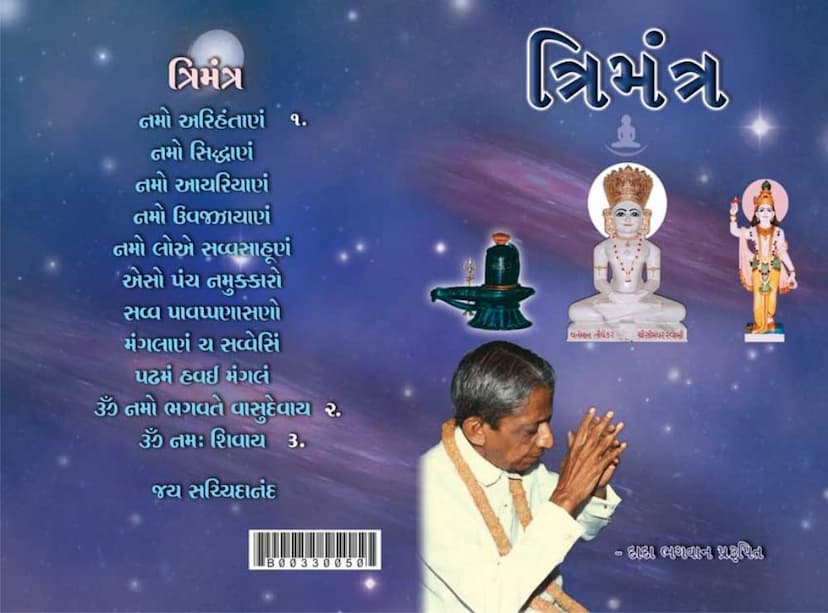Trimantra
Added to library: September 2, 2025

Summary
This document is a book titled "Trimantra" authored by Dada Bhagwan, published by Dada Bhagwan Foundation. The catalog link provided is for JainQQ.org. The text is in Gujarati and details the "Trimantra" which combines three significant mantras from different spiritual traditions: the Jain Navkar Mantra, the Vaishnav mantra "Om Namo Bhagavate Vasudevaya," and the Shaiv mantra "Om Namah Shivaya."
Here's a comprehensive summary of the content:
Core Concept:
The "Trimantra" as presented by Dada Bhagwan is a compilation of these three powerful mantras, intended to be recited together. The fundamental purpose behind this unification is to promote nishpakshpati (non-partisanship) and encompass the essence of universal spiritual truth, transcending sectarian boundaries. Dada Bhagwan emphasizes that the Divine is not partial to any particular religion or sect.
Structure of the Book:
-
Page 1: Introduces the "Trimantra" itself, listing the mantras:
- The Jain Navkar Mantra (Namokar Mahamantra)
- "Om Namo Bhagavate Vasudevaya" (Vaishnav mantra)
- "Om Namah Shivaya" (Shaiv mantra)
- "Jai Sachchidanand" (A phrase of ultimate spiritual realization)
-
Page 2-3: Provides publication details, listing the publisher (Dada Bhagwan Foundation), editor (Dr. Niruben Amin), and other publications by the foundation. It also includes information about the author, Dada Bhagwan.
-
Page 4: Offers a brief biography of Dada Bhagwan, describing his spiritual awakening in 1958 and his unique "Akram Marg" (Accidental Path) which allows for rapid spiritual progress. It highlights his childhood experiences and how he perceived spiritual truths even in mundane situations.
-
Page 5 (Editorial): The editor, Dr. Niruben Amin, explains the rationale behind the "Trimantra." She states that throughout history, spiritual founders like Mahavir Bhagwan, Krishna Bhagwan, and Rama Bhagwan have focused on the "Atmadharma" (Self-religion) rather than sectarian identities. She emphasizes that the Trimantra is impartial and salutes highly realized souls across different paths, removing obstacles and guiding towards liberation. The editor highlights that the meaning and purpose of these mantras are further explained through Q&A with Dada Bhagwan.
-
Page 6-28 (Q&A with Dada Bhagwan): This is the most extensive part of the book, where Dada Bhagwan elaborates on the Trimantra and related spiritual concepts through a question-and-answer format. Key themes discussed include:
- The Purpose of Combining Mantras: To overcome religious divisions and embrace a universal, non-sectarian approach. The integration of these mantras is seen as restoring the original intent of spiritual teachings.
- The Navkar Mantra: Dada Bhagwan meticulously explains the meaning of each line of the Navkar Mantra. He emphasizes the importance of reciting it with understanding and correctly addressing the Arhantas (presently living Tirthankaras like Simandhar Swami, not merely the past 24 Tirthankaras who are now Siddhas). He stresses that the Navkar mantra's efficacy is diminished when individual religious groups claim it exclusively.
- The Vaishnav Mantra ("Om Namo Bhagavate Vasudevaya"): Dada Bhagwan explains that Vasudev refers to those who have attained the state of Narayan from being human (Nar). He details the lineage of Vasudevas and Prati-Vasudevas (antagonists), including figures like Krishna, Rama, and Ravana, highlighting their spiritual significance and potential future Tirthankara status. He emphasizes the importance of respecting these spiritual figures without criticism.
- The Shaiv Mantra ("Om Namah Shivaya"): Dada Bhagwan clarifies that "Shiva" refers to anyone who has attained a state of auspiciousness and whose ego has dissolved, not a specific person. He explains the concept of Shankara as one who bears the "poison" (difficulties, criticism, etc.) of the world with equanimity, becoming a facilitator of welfare. He contrasts this with superficial chanting without inner transformation.
- "Jai Sachchidanand": This phrase is presented as the ultimate realization of the Self.
- The Power of Mantras: Dada Bhagwan explains that reciting these mantras, especially with sincere intent and understanding, can alleviate worldly obstacles and soften the impact of karma. He clarifies that while mantras help navigate worldly challenges, true self-realization requires Atmajnan (Self-knowledge) given by a Gnani Purush (Self-realized being).
- Understanding and Usage: He stresses the importance of understanding the meaning of the mantras and reciting them with focused intent. He explains that the "Akram Marg" facilitates this understanding and the effective use of these spiritual tools. He also advises reciting them aloud in solitude for greater impact.
- The Role of "Vyavasthit": Dada Bhagwan connects the efficacy of the mantras to the divine order of Vyavasthit (the science of the universe). He suggests that the ability to recite the mantras effectively is also part of this cosmic order.
- The Nature of Sadhus/Saints: He defines a true sadhu as one who is striving for or has attained the state of the Self (Atmadasha), not merely those who adopt external renunciation.
-
Page 29: Lists various prayerful salutations (Namaskar Vidhi) that can be recited, addressing different spiritual figures and principles, including the current Tirthankara Simandhar Swami, the five supreme beings (Panch Parmeshthi), and the "Real" form of all beings. It also provides contact information for obtaining the book.
Overall Message:
"Trimantra" by Dada Bhagwan is a spiritual guide that seeks to unify different paths by presenting a set of powerful mantras that are universally applicable. It emphasizes that true spirituality lies in understanding the essence of these mantras, practicing them with sincere intent, and ultimately seeking Self-realization, which is facilitated by a Gnani Purush. The book promotes an inclusive and non-sectarian approach to spiritual practice, aiming to remove divisions and guide individuals towards inner peace and liberation.